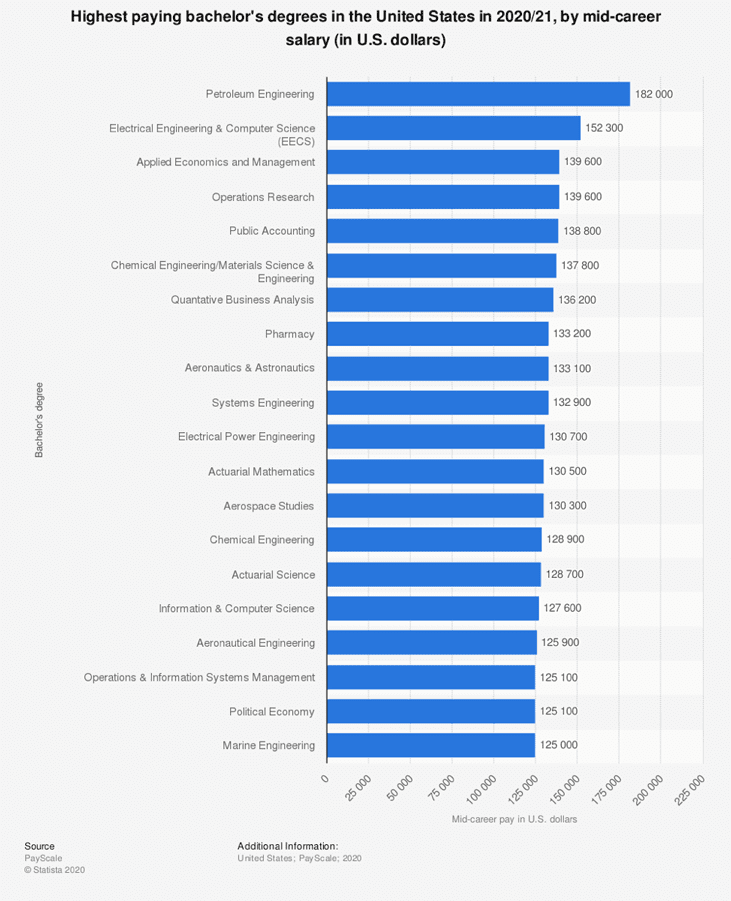Despite the advances that renewable sources of energy can provide, the use of fossil fuels is not dead nor is the future for those working in the petroleum industry. However, the discipline is in transition like the industry itself.
If a recent article in the New York Times describing the plight of several disillusioned petroleum engineering (PE) students graduating this semester is any indication, Chicken Little might be right: The sky is falling. There are few offers or opportunities for new PE grads, the future for petroleum engineering looks murky, and the boom and bust cycle, common to the oil and gas industry, has been even more stark during COVID-19.
Although this is not the time to downplay or belittle honest concerns about one’s future in an industry that has had severe economic twists and turns over the years, a look at the facts shows a different picture.
To be sure, it’s been a hell of a year for everyone; COVID-19 issues have not been kind to anyone, and for 2021 PE and other new graduates, academic life has been upended. Most students were displaced at the beginning of the pandemic, when colleges and universities had to shutter their doors, making important lab and research work virtually impossible.
Given the current climate, it is understandable that there is worry and concern among new and potential PE graduates in the pipeline as well as already employed petroleum engineers.
The oil and gas industry and its relationship with its engineers has always been cyclical in response to world oil politics, price fluctuations in the commodities markets, and now the keen interest in renewables. Despite several tumultuous economic cycles, the industry has always managed to come back as evidenced by statistics and economic drivers.
There are more than 17,000 petroleum engineers in the United States today, many of them graduates from PE programs at prestigious American universities, such as Texas A&M, the University of Texas – Austin, Colorado School of Mines, and others. In fact, Texas A&M International University (TAMIU) in Laredo, Texas, just recently approved the creation of a PE degree program.
According to the Bureau of Labor Statistics (BLS), employment of petroleum engineers is projected to grow three percent from 2019 to 2029, about as fast as the average for all occupations. Oil prices will be a major determinant of employment growth. Higher prices can cause oil and gas companies to increase capital investment in new facilities and expand existing exploration and production (E&P) activities.
Salaries for petroleum engineers have remained strong as well.

Why PEs are Here to Stay
Last summer, the Society of Petroleum Engineers sponsored a webinar called The Way Ahead for Petroleum Engineering with Dr. Jeffrey B. Spath, chair of PE at Texas A&M, College Station, and Dr. Jennifer Miskimins, head of PE at the Colorado School of Mines, Golden. Both were aware of the jitters new graduates and new to the field PEs were experiencing, with Miskimins acknowledging that many students are deeply concerned that PE will be “disappearing” with the increased interest in renewables. She stressed that the rising use of renewables will be more of a transition than a “switch.” PEs will still be needed for their expertise and training and can expect career growth.
Spath also acknowledged the worries of students regarding petroleum engineering’s “death,” stressing that the oil and gas industry looks to “problem solvers,” and PE students are trained to provide solutions. Another important takeaway is the fact that many PE engineering skills can be transferred to other areas of the industry.
Also significant are findings discussed by Dr. Lloyd Heinze, a PE professor at Texas Tech University, who tracks PE enrollment figures. At the 2019 SPE Annual Technical Conference and Exhibition in Calgary, he told the audience that he expected the number of PE degrees conferred to continue dropping in 2020.
His prediction came from a paper he co-authored, and which was published in the SPE Journal. It is based on statistics provided by PE department heads at the beginning of every academic year. In his observations, he concluded that petroleum engineering enrollment and the resultant degrees are influenced by oil and gas prices, noting that the changes lag prices by 2.5 years. Although most of the data came from American universities, for the last five years, the research has included non-American programs, too.
Highlights of the study, contained in SPE 195908, also showed the number of U.S. colleges and universities offering PE accredited programs had dropped from 35 to 20. Interestingly, PE programs in non-American schools have been steadily increasing since 2016.
Dr. Pablo Arenaz, president of TAMIU, emphasizes, “No future is without change and no future comes with a guarantee. The oil and gas industry is predicated on challenge and risk and it has always responded to both with commitment, intelligence and grit. The future of the industry will be no different.”
He is quick to point out, “Oil and gas have been and will continue to be an industry of both great history and promise for years to come.”
New directions in petroleum education might not be the same as they were in previous generations. Arenaz stresses, “We will encourage flexibility in our program development to accommodate teaching of cleaner/greener energy concepts and work to create graduates who can be nimble in their response to the changing needs of the industry.”
No question, a college education is expensive and working toward a degree in petroleum education is not easy. The last thing an upperclassman wants to hear is that initial career opportunities in the discipline may be limited or even dwindling.
So, should a student considering a petroleum engineering degree now look at the situation in the same way as Chicken Little’s proverbial falling sky?
Chicken Little Might Need an Umbrella
Arenaz stresses that he would tell prospective petroleum engineering students “the same as I would provide any student pursuing any degree program: research the field, look at all the options, meet with seasoned professionals working in the field and get their insight. Many have seen the industry through highs and lows and can attest to what professionals can do to weather these changes and what newcomers to the field might do to help ensure their success.”
In reference to the university’s new PE degree program, Arenaz says, “The addition of PE to our engineering inventory has been a direction for the School of Engineering and the university since 2010 and reflects our commitment to develop degree programs that are responsive to the needs of this south Texas region and the state of Texas.” The program was recently approved after a 10-year campaign following the vision of Texas oilman Cliffe Killam, president and partner at privately owned Killam Oil.
Still Concerned About the Future?
At the conclusion of bp’s annual energy outlook meeting in March 2020, then-CEO Bob Dudley sought to allay the fears of a worried student who questioned the future of petroleum engineering. “A job or training as an engineer of any kind is so important. There is going to be a huge need for that.”
To listeners still concerned about the role of petroleum engineers in the future, he referred to a presentation made by Spencer Dale, group chief economist for bp, whose outlook showed “oil demand likely will be growing until 2030, and remaining around 100 million bbl/d through 2050 while natural gas demand continues to rise.”
Dudley pointed out that the most downloaded SPE paper in 2019 on OnePetro was “The End of Petroleum Engineering as We Know It.” While it describes the challenges PEs will face in years to come, in Arenaz’s opinion, “Bright, committed and intelligent petroleum engineers will always have a future.”
The View from Canada
 Are petroleum engineers at risk for extinction in the U.S.’s northern neighbor?
Are petroleum engineers at risk for extinction in the U.S.’s northern neighbor?
It doesn’t seem so, if analysts at Ian Martin Group, an employment consultancy based in Oakvlle, Ontario, Canada, are correct.
In a blog post on their website, the analysts believed Canada’s petroleum industry was set to rebound in 2017. The analysts estimated that job growth would surge to 300 percent by 2018 before slowing slightly to 200 percent by 2024. “Regardless, prospects don’t look as grim as they once did for these engineering jobs in Canada,” they wrote.
And, there also seems to be some other good news from north of the border as well.
According to the researchers, demand isn’t the only selling point for petroleum engineers. “Median salaries hover just below $105,000 per year, so these professionals can expect to live large. Petroleum engineers can also seek work with a wide variety of employers, from government or research organizations to oil extractors and more.”
Headline photo courtesy of Guillermo A. Sosa. President and Partner Cliffe Killam (L), Killam Oil & Gas, and President Pablo Arenaz (R), Texas A&M International University (TAMIU).
Claudia M. Caruana is a New-York based science and environmental writer who teaches at NYU’s Stern School of Business.






